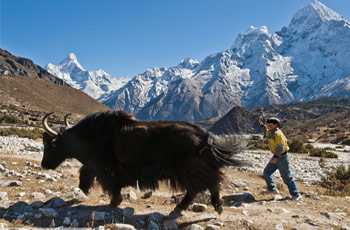Sagarmatha National Park
– The Heights of Nature and WildlifeSagarmatha National Park is unique in all respects. Unlike other national parks boasting forests and wildlife, Sagarmatha has something else as its sole differentiator. Unquestionably, this is located at the zenith of planet earth. Yes, we are right. It is located in the north-eastern Himalayas and is dominated by the Mount Everest, the highest point of earth (8,848 m.) It was added to the list of world heritage site in 1979 for its unparalleled beauty and showcasing the wonder of the planet in the form of the mountain.
 Sagarmatha is Nepali name for Everest; hence the national park is the namesake of the mountain and is also a world heritage site as well. Besides boasting heights, the region also serves as a thriving ground for some of the many rare and endangered species like snow leopard, red panda, musk deers, pheasants, Himalayan Tahr, black bears, weasel, jackal, etc. The yaks can be spotted here as well, and the legends of yetis on the route might come alive and cross your way as well, though the chances are rare.
Sagarmatha is Nepali name for Everest; hence the national park is the namesake of the mountain and is also a world heritage site as well. Besides boasting heights, the region also serves as a thriving ground for some of the many rare and endangered species like snow leopard, red panda, musk deers, pheasants, Himalayan Tahr, black bears, weasel, jackal, etc. The yaks can be spotted here as well, and the legends of yetis on the route might come alive and cross your way as well, though the chances are rare.
Naturally, the region again features a rare and enchanting mix of mountains, glaciers, glacial lakes, deep valleys, alpine forests and pastures. The park has to its credit unique forests ecosystem. The vegetation at lower elevation features pine and hemlock forests, whereas the upper reaches are dominated with silver fir, birch, junipers and rhododendron trees.
Apart from natural wonders, the region is also a rich way to experience the rich Sherpa culture, their monasteries and cultural landmarks. Sherpas are the elite mountaineering locals who are now seen as a carrier of the region’s alpine culture. Exposed to the high altitudes since their birth, these nomads are renowned in the international world and mountaineering community as enduring experts of mountaineering. Every Sherpa boy gets exposed to the very high altitudes, and hence as a result, he develops sturdiness and impressive authority in the adventure of climbing mountains.
During a trip to Sagarmatha National Park, tourists get to meet Sherpa community whose home is a part of the park, participate in cultural exchange and contribute to their sustenance of life.
Namche – It is the location where all the tourist activities in Sagarmatha region are centered. There is a park visitor center here that has a lot to offer in terms of knowing the region. It has an information desk and a Sherpa cultural museum that introduces the park to the first time visitor. It even builds the travellers’ curiosity to explore more of the region in depths.
Monasteries – There are two monasteries in the region that are seen as religious centers of the region. In fact, the serene monastic culture here represents the different side of mountains, i.e. peace and calm. Thame, Khumjung, Namche and Pangboche are the four prominent monasteries active in the area.
How to Reach Sagarmatha National Park
Airport – Arrive at Lukla via a 30 min flight from Kathmandu. From Lukla, it takes two day of treks to reach Sagarmatha National Park.
Trekking is the only way through which one can reach the reserved Sagarmatha region.
Best time to reach Sagarmatha
The period between Oct-Nov and Mar-May are the best months of visiting Sagarmatha National Park.
Festivals of Sagarmatha
The festivals here are religious in nature. Mani Rimdu festival is celebrated in the month of May at Thame Gompa. Dumje festival leads the celebration in the month of June at the gompas of Khumjung, Namche and Pangboche.












